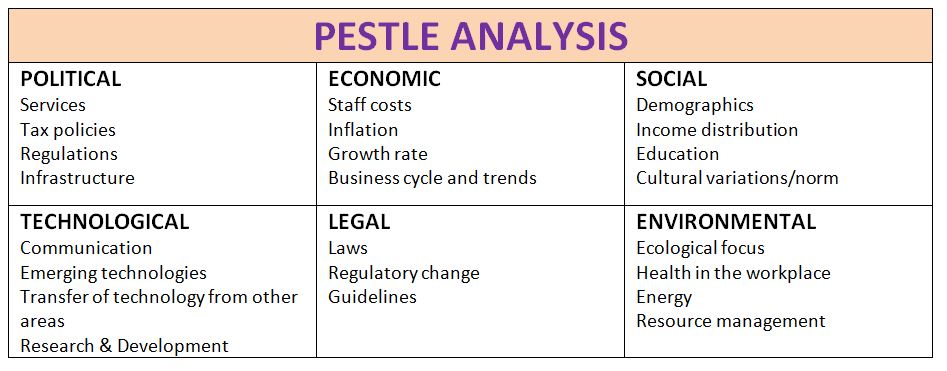Are you working in your business or working on your business?
When reviewing your business, whether as a manager or as a business owner, it is sometimes overwhelming as you try to decide what information is important and why. You may use your business review to decide the direction of the business for the next 12 months or even as part of a three or five year plan. Read on to discover the tools and models which could help you.
PESTLE analysis
A PESTLE analysis (formerly known as PEST analysis) is a framework or tool used to analyse and monitor external factors that may affect an organisation’s operations/performance. This tool is especially useful when starting a new business or entering a new market.
Sometimes the concept of Ethics is added, making this a STEEPLE analysis.
It’s important when undertaking such an analysis that the factors affecting the organisation are not just identified but are also assessed – for example, what impact might they have on the organisation?
It is used in conjunction with SWOT and Porter’s 5 Forces model to give clear understanding of both internal and external factors that may affect an organisation. The outcomes of a PESTLE analysis can be used to populate the opportunities and threats in a SWOT analysis.

Political factors:
These will determine the extent to which government and/or government policy may impact on an organisation or a sector. This would include political policy and stability/instability as well as trade, fiscal, labour law, environmental law and taxation policies too.
Economic factors:
These factors impact on the economy and its performance, which in turn directly impacts on the organisation and its profitability. Factors include interest rates, employment or unemployment rates, rates of inflation, disposable income, raw material costs and currency exchange rates.
Social factors:
These factors focus on the social environment and identify emerging trends. This helps you to further understand your customers’ needs and wants. Factors include changing demographics, education levels, cultural trends, population changes, attitude changes and lifestyle attitudes.
Technological factors:
These factors consider the rate of technological change, innovation and developments that could affect a market or industry in a positive or negative manner. Factors could include changes that advise your company against spending a lot of money on developing a technology that would become obsolete very soon due to disruptive technological changes elsewhere, automation, research and development. There is often a tendency to focus on developments only in digital technology, but consideration must also be given to new methods of distribution, manufacturing and also logistics.
Legal factors:
An organisation must understand what is legal and allowed within the territories they operate in, especially if they trade in more than one country as laws may differ. They also must be aware of any change in legislation and the impact this may have on business operations. Factors include employment legislation, consumer law, discrimination law, health and safety, international as well as trade regulation and restrictions. Political factors do cross over with legal factors; however, the key difference is that political factors are led by government policy, whereas legal factors must be complied with.
Environmental factors:
These factors relate to the influence of the surrounding environment and the impact of ecological aspects. With the rise in importance of corporate sustainability responsibility, this element is becoming more important. Factors include ecological factors, climate change, recycling procedures, carbon footprint, waste disposal and sustainability.
Useful web links:
Download here

